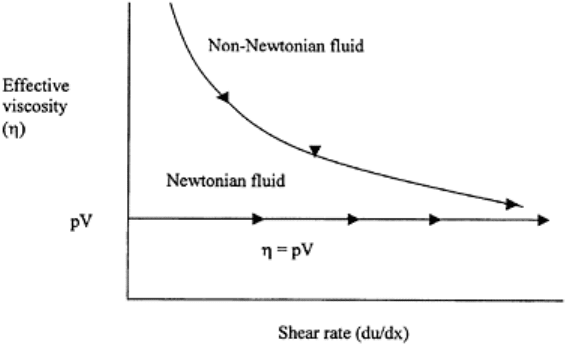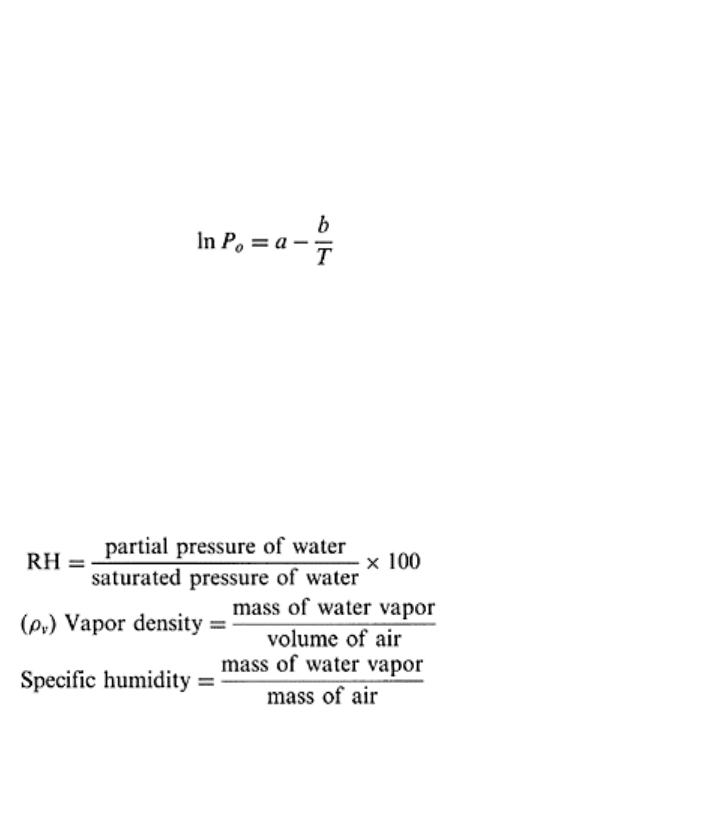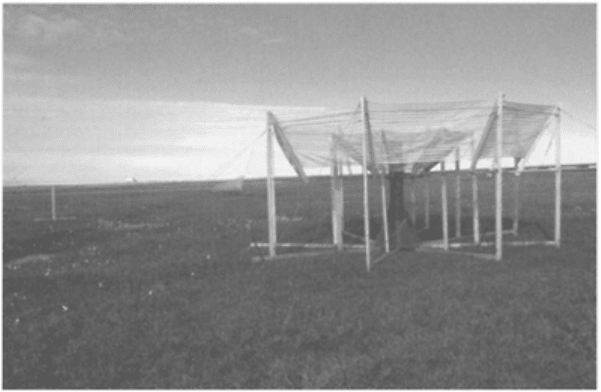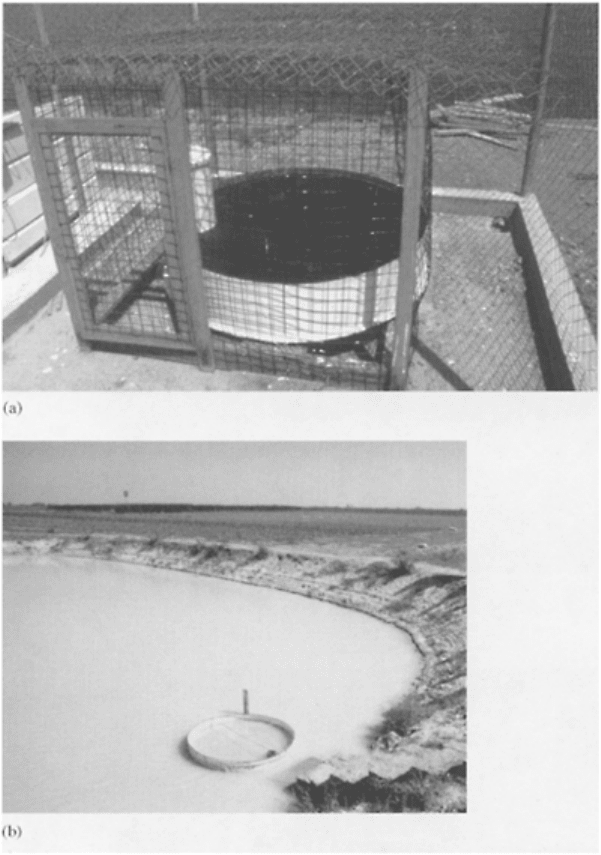Lal R., Shukla M.K. Principles of Soil Physics
Подождите немного. Документ загружается.


where S
v
is solubility expressed in terms at volume ratio, and C
v
is volume of dissolved
gas relative to the volume of H
2
O.
9.1.7 Viscosity
Viscosity of a fluid is its resistance to flow. For example, water has lower viscosity than
syrup or honey. When fluid is moved in shear (adjacent layers of fluid are made to slide
over each other), the force required is proportional to the velocity of shear. The
proportionality factor is called viscosity (η). It is the property of fluids to resist the rate of
shearing, and can be visualized as an internal friction.
The coefficient of viscosity η is defined as the force per unit area necessary to
maintain a velocity difference of 1 cm/sec between two parallel layers of fluid that are 1
cm apart. The viscosity equation is shown in Eq. (9.15).
(9.15)
where τ is shearing stress, F
s
is force, A is area of action for the force, and du/dx is
velocity gradient normal to the stressed area.
Kinematic Viscosity (η
к
)
The ratio of the viscosity to the density of the fluid is called the kinematic viscosity (η
к
).
It expresses the shearing-rate resistance of a fluid mass independently of the density.
While η of water is about 50 times more than that of air, ηк of water is actually lower.
Viscosity has the units of poise or centipose (see Appendix 9.1 and Appendix L).
9.1.8 Newtonian and Non-Newtonian Fluids
Newtonian fluids obey Newton’s law of viscosity, which states that shear stress (τ) is
proportional to shear rate, with the proportionality constant being the coefficient of
viscosity (η) as shown in Eq. (9.15) and Fig. 9.8.
For solids, shear stress divided by shear strain gives an elastic modulus [refer to Eq.
(7.17)]. For viscous liquids, since the strain is increasing all the time, shear stress divided
by the rate of shear strain gives the viscosity coefficient. Newtonian fluids have a
constant viscosity at a given temperature. Examples of Newtonian fluids are water, salt
solution, milk, mineral oil, etc. In general, all gases and most liquids with simpler
molecular formula and low molecular weight (e.g., water, benzene, ethyl alcohol, CCl
4
,
hexane, and most solutions of simple molecules) are Newtonian fluids.
Non-Newtonian fluids do not obey Newton’s law of viscosity. Such fluids have a
variable viscosity at a constant temperature η=f(t), and viscosity depends on the force
applied (time and temperature).
(9.16)
Principles of soil physics 244

where v is the velocity and x is the distance, η is the apparent viscosity and is not a
constant (Fig. 9.8). Examples of non-Newtonian fluids are a syrupy mixture of cornstarch
and water, quicksand, slurries, pastes, gels, polymer solutions, etc.
In some non-Newtonian fluids, properties are independent of time under shear. Such
fluids include the following:
Bingham Plastic
These fluids resist a small shear stress but flow easily under larger shear stresses e.g.,
toothpaste, jellies, and some slurry.
Pseudoplastic
Viscosity of the fluids decreases with increasing velocity gradient (e.g., polymer
solutions, blood). Pseudoplastic fluids are also known as shear thinning fluids. At low
shear rates (dv/dx) the shear thinning fluid is more viscous than the Newtonian fluid, and
at high shear rates it is less viscous. Most non-Newtonian fluids fall into this group.
FIGURE 9.8 Newtonian and non-
Newtonian fluids.
Dilatant Fluids
Viscosity of these fluids increases with increasing velocity gradient. They are
uncommon, but suspensions of starch and sand behave in this way. Dilatant fluids are
also called shear thickening fluids.
In other non-Newtonian fluids, properties are dependent upon duration of shear. Such
fluids include the following:
Water 245

Thixotropic Fluids
For thixotropic fluids the dynamic viscosity decreases with the time for which shearing
forces are applied (e.g., thixotropic jelly paints).
Rheopcctic Fluids
For Rheopectic fluids the dynamic viscosity increases with the time for which shearing
forces are applied (e.g., gypsum suspension in water).
Viscoclastic Fluids
Viscoelastic fluids have elastic properties, which allow them to spring back when a shear
force is released (e.g., egg white).
9.1.9 Fluidity
Fluidity is the reciprocal of viscosity and has the units of 1/poise or 1/centipose.
(9.17)
Fluids of lower viscosity flow more readily than those of high viscosity. The fluidity of
water increases by about 3% per 1°C rise in temperature. The fluidity is also affected by
the type and concentration of solutes.
9.1.10 Vapor Pressure
The change of state of water from liquid to vapor phase is related to the kinetic theory.
The molecules in a liquid move past one another in a variety of speeds. A molecule in the
upper regions of the liquid with a high speed may leave the liquid momentarily and fall
back. Others with a critical speed may escape. The number of molecules with high KE
increases with increase in temperature.
Evaporation E α T
Water evaporation is an endothermic process. When H
2
O molecules with high energy
escape, the velocity and kinetic energy of those remaining is less, the lesser the velocity
the lower is the temperature. The liquid is, therefore, cool.
Saturated Vapor Pressure
The vapor is in equilibrium with a liquid because the rate of molecules escaping and
those returning back by condensation is equal.
The equilibrium exists when the space is saturated. The pressure of the vapor when it
is saturated is called the “saturated vapor pressure.” The saturated vapor pressure does
not depend on the size of the container. It depends on:
Principles of soil physics 246

1. Pressure of water
2. Temperature of water
3. Chemical condition (solutes)
Boiling Point
Water boils at a temperature when vapor pressure becomes equal to atmospheric
pressure. The saturated vapor pressure is related to the temperature (T) as per the
simplified version of the Clasius–Clapeyron equation [Eq. (9.18)].
(9.18)
where In P
o
is logarithm to the base e of the saturation vapor pressure P
o
, T is absolute
temperature, and a and b are constant.
Pressure of the liquid water also affects vapor pressure. Water in soil is a dilute
solution of various electrolytes. The vapor pressure of electrolytes is lower than that of
pure water, soil-water also has a lower vapor pressure even when the soil is saturated. In
an unsaturated soil, capillary and adsorptive effects further lower the potential and the
vapor pressure.
Vapor pressure is expressed in units of pressure, e.g., dynes/cm
2
, bar, mm of Hg, or
water. The vapor pressure of atmosphere can also be expressed in the following different
ways:
1.
2.
3.
4. Saturation (or vapor pressure) deficit=the difference between the existing vapor
pressure and the saturation vapor pressure
5. Dew point temperature: The temperature at which the existing vapor pressure becomes
equal to the saturation vapor pressure, i.e., the temperature at which a cooling body of
air with a certain vapor content will begin to condense dew.
9.2 THE HYDROLOGIC CYCLE
Water is a completely renewable resource. It changes from one form to another and from
one environment to another. Water transfer or movement from one form and/or one
environment to another governs the hydrologic cycle (Fig. 9.9). The hydrologic cycle
involves interchange (fluxes) between principal pools. These fluxes are: (i) evaporation,
transpiration, or evapotranspiration (red water) by which water enters the atmosphere, (ii)
precipitation by which returns to the land and ocean, and (iii) infiltration, percolation,
Water 247

interflow, and runoff or overland flow by which water is returned from land to streams,
rivers, lakes, and oceans (blue water). Soil water (green water) is a principal pool of the
freshwater reserves. The magnitude of these pools and fluxes is shown in Fig. 9.9.
The data in Fig. 9.9 and Table 9.3 can be used to calculate the mean resident time (T
r
)
which is equal to the mass/flux. The T
r
for water in the atmosphere, streams/rivers, and
oceans is given by Eqs. (9.19) to (9.21).
T
r
atmosphere=13,000 Km
3
/496,000 Km
3
per yr=0.026/yrs
(9.19)
FIGURE 9.9 Schematic of global
transfer rates (km
3
/ yr) for water
movement in the hydrologic cycle.
(Flux rates are from Spiedel and
Agnew, 1982 and Alley et al., 2002).
TABLE 9.3 Major Water Pools and the Mean
Residence Time (Tr) of Water in Specific Pool
Pool Capacity (Km
3
) Flux (Km
3
/yr) Tr (yr)
Oceans 1,370,000,000 425,000 3223.5
Freshwater lakes 125,000
Saline lakes and inland seas 104,000
Rivers and streams 1,300 40,000 0.0325
Glaciers and ice caps 29,200,000
Soil water 67,000 111,000 0.604
Groundwater 8,350,000
Principles of soil physics 248

Atmosphere 13,000 496,000 0.0262
Source: Calculated from Spiedel and Agnew, 1982, and Alley et al., 2002.
T
r
streams/rivers=1,300 Km
3
/40,000 Km
3
per yr=0.033 yrs
(9.20)
T
o
oceans=1,320×106 Km
3
/485×103 per yr=3,100yrs
(9.21)
Therefore, atmospheric and stream/river pools are highly dynamic and can transfer
contaminants or pollutants from one pool to another very rapidly. The T
r
of water in soil
is highly variable, and depends on soil properties.
9.3 SOIL AS A RESERVOIR OF WATER
The total pool of soil-water is estimated at about 67,000 Km
3
. In terms of the freshwater
reserves, soil is, in fact, a very efficient storage system. Assume that a one-hectare area of
soil has water content of 20% by weight in the top 1-m depth with an average bulk
density of 1.25 Mg/m
3
. The total amount of water in the soil is 0.25 hectare-meter,
2.5×10
3
Mg, 2.5×10
6
Kg, or 2.5×10
6
L. This is indeed a large quantity of water. If human
consumption of water is about 100 L/day, this water is enough for one person for 2.5×10
4
days or 68.5 years or for 25,000 people for one day. If half of this water were available
for plant uptake at the consumptive use rate of 0.5 cm/day, it can support plant growth for
25 days.
Rather than the absolute quantity, it is often change in the soil-water pool that is of
major interest. The change in the soil-water pool can be computed from the water balance
Eq. (9.22).
∆S=P+I−(R+D+ET)
(9.22)
where ∆S is the change in the soil-water pool, P is precipitation, I is irrigation, R is
surface runoff, D is deep drainage, and ET is evapotranspiration. Different components
listed in Eq. (9.22) are determined by lysimetric evaluation.
9.4 COMPONENTS OF THE HYDROLOGIC CYCLE
Different components of the hydrologic cycle are outlined in Eq. (9.22), which is
normally written in a form to solve for ET [Eq. (9.23)].
ET=P+I−(R+D)± AS
(9.23)
Therefore, different components of the hydrologic cycle include: (i) precipitation (P)
including rain, snow, hail, fog, mist, (ii) irrigation (I) is not a component in natural
ecosystem but is an important factor in the hydrologic cycle of managed and especially
Water 249
agricultural ecosystems in arid and semi-arid regions, (iii) R is surface runoff, (iv) D is
deep drainage leading to groundwater recharge, (v) ∆S is change in soil water storage,
and (vi) ET is evapotranspiration. Methods of measurement and estimation or prediction
of evapotranspiration are described in detail by Monteith (1985), and standard methods of
measuring precipitation are discussed in texts on climatology or any hydrologic manual
(USDA, 1979).
9.4.1 Precipitation
Accurate measurement of precipitation is important for reliable assessment of the water
balance. In addition to simple or non-recording and recording rain gauges normally used
at the meteorological stations (Figs. 9.10–9.13), rainfall measurement under a vegetation
cover involves measurement of: (i) through fall using a spider gauge (Fig. 9.14a), and (ii)
stem flow (Fig. 9.14b). Measurement of through fall and stem flow can be highly variable
depending on the tree canopy and foliage characteristics.
9.4.2 Runoff
There are numerous methods of measuring surface runoff for different scales. The scale
may range from a microplot of a few square meters to a watershed of several Km
2
or
more (Table 9.4). Hydrologic parameters that are measured to compute surface runoff
include total volume stage or water level, velocity, discharge, and their variation over
time. Installation, measurements, and calibration procedures of these devices are
described in USDA (1979), and shown in Figs. 9.15–9.18.
9.4.3 Lysimetric Analysis
A lysimeter is a confined volume of soil, in which input, output and change in water
storage can be quantified. The size, shape, and material used in constructing lysimeters
vary widely.
Principles of soil physics 250

FIGURE 9.10 A meteorological
station installed within a rice paddy.
Lysimeters may be square (Fig. 9.19) or circular (Figs. 9.20–9.22), and made of steel,
galvanized material, fiberglass, or plastic. Hydrologic inputs comprise precipitation and
supplemental addition of water depending upon the management systems imposed.
Hydrologic output comprises deep drainage or percolation water.
Water 251

FIGURE 9.11 Recording and non-
recording rain gauges.
FIGURE 9.12 A snow gauge.
Principles of soil physics 252

FIGURE 9.13 (a) Class A pan
evaporemeter; (b) a device to measure
evaporation in a lake.
Changes in soil-water storage can be measured by using neutron moisture meter or
gypsum blocks.
There are several types of lysimeter depending on the method of construction, and
evaluating hydrologic balance. Common types of lysimeters are outlined in Table 9.5.
Water 253
